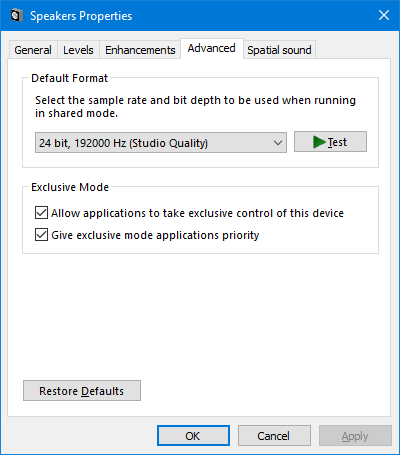wilflare
100+ Head-Fier
- Joined
- Jun 19, 2005
- Posts
- 257
- Likes
- 14
one curious question - what should I set my Eitr windows sound format to? 16bit 48000hz?
Good question I just pulled it up on my iMac And it is showing 16bit 48000hz For me as well. Should I change To 44100.0Hz 16bit Or leave it the way it is?one curious question - what should I set my Eitr windows sound format to? 16bit 48000hz?
It should, as far as I know...Am I correct that dsd files won't play with the eitr in the chain?
I just set everything to 24/192 and call it a day.Are you folks talking about looking at Eitr settings in the MAC's Audio Midi Setup window? Thanks.
Yes.Are you folks talking about looking at Eitr settings in the MAC's Audio Midi Setup window? Thanks.
It should, as far as I know...
I just set everything to 24/192 and call it a day.
I have no idea as I don't use Windows based PCs.does that mean Windows will try to upsample the files to 24/192?
does that mean Windows will try to upsample the files to 24/192?

Interesting. I've seen these initials many times, but never knew what they related to or what they stood for (as I am Mac user). Does WASAPI stand for Windows Audio Settings API? What does ASIO stand for? Audio System Input Output? It seems the (non-intuitively named) Speakers control panel functions equivalently/analogously to the Mac Audio Midi Setup control panel.
Here is the window where you set it. Windows will upsample only when used in shared mode. That is if you use the system default audio device after you assign Eitr to be your system default audio device, which I don't do. My built-in sound card connected to my computer speakers is system default.
When used in ASIO or WASAPI mode the application (JRiver, Foobar etc.) will have an exclusive access and will be able to send the stream in whatever sample rate.
No, WASAPI is Windows Audio Session API (and API stands for Advanced Programming Interface). And ASIO is Audio Stream Input/Output. Here and here are shorter explanations.Interesting. I've seen these initials many times, but never knew what they related to or what they stood for (as I am Mac user). Does WASAPI stand for Windows Audio Settings API? What does ASIO stand for? Audio System Input Output? It seems the (non-intuitively named) Speakers control panel functions equivalently/analogously to the Mac Audio Midi Setup control panel.
Thanks.No, WASAPI is Windows Audio Session API (and API stands for Advanced Programming Interface). And ASIO is Audio Stream Input/Output. Here and here are shorter explanations.
To me Windows' "Speakers" sounds more intuitive than Mac's "Midi" because it has nothing to do with Midi setup. In computer hardware hierarchy there can be several sound cards (called "sound controllers" in Windows) and each card can have several sound outputs such as S/PDIF (Coax and optical), Midi, AES/EBU, regular line out, amplified for headphones etc. Windows calls "line-out" as "Speakers".


